Hierarchy (Taratamya) Meaning in Hinduism | What is the Hierarchy of Gods (Vedas) in Hinduism? | What is the hierarchy of god? | Who is the god above all in Hinduism? | What is the structure of the Hindu god? | Is Hierarchy good or bad to humanity?
Namaste friends, how are you doing today? Welcome to #BhagavanBhakthi website / blog.
Bhagavan Lord Sri Vishnu (Krishna, Rama, Trivikrama, Narasimha, Vamana, Vasudeva, Mukunda) and Goddess Lakshmi (Rukmini, Satyabhama, Sita, Kamala, Maya) blessings to you and your family!
In this website / blog, you will always learn about #Hinduism #Sanskrit language.
Also subscribe to my YouTube channel from this link #BhagavanBhakthi to view videos about #Hinduism #Sanskrit language.
Just before moving towards to know about “Hierarchy (Taratamya) Meaning in Hinduism | What is the Hierarchy of Gods (Vedas) in Hinduism? | What is the hierarchy of god? | Who is the god above all in Hinduism? | What is the structure of the Hindu god? | Is Hierarchy good or bad to humanity?“, let us know few basic and important information.
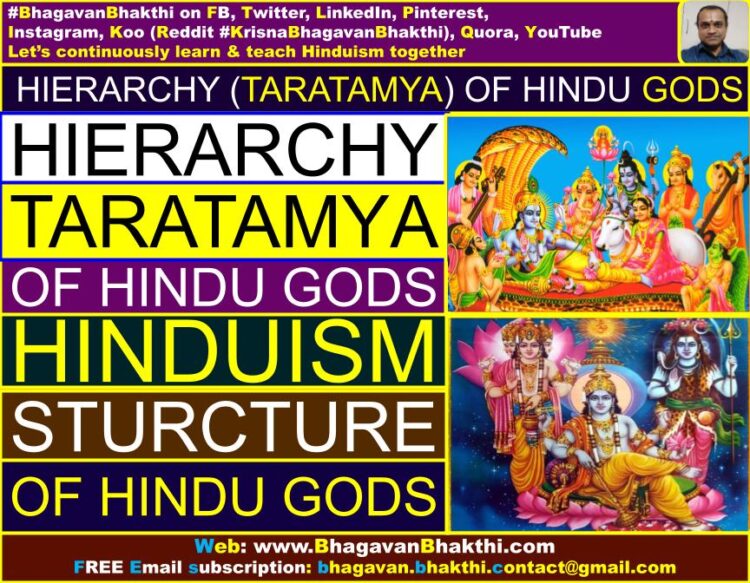
In Bharata (India) there are different sampradayas / traditions exists from north Kashmir to south Kanyakumari and from west Gujarat to east Arunachal Pradesh.
Each and every sect and tradition have their own unique way of thinking, all have their own unique way of living, all have their own unique way of dressing style, all have their own unique foods, all have their own unique style of talking, all have their own unique language, all have their own way of tastes etc.
There is no similarity between two sects and traditions not only in India, but in the whole world too. One person’s taste can’t be your taste, and your taste can’t be the other person’s taste.
Your way of talking can’t be my way of talking and my way of talking can’t be your way of talking and similarly, food, dress, living style, language, etc.
Likewise, your interest can’t be another person’s interest and similarly another person’s interest can’t be your interest. One person talks very loudly and another person talks without making too much of noise.
One person talks very fluently and another person has problems in talking fluently. One person will be almost healthy throughout his / her life, while someone else will always be having health issues throughout his / her life.
A child who is just 5 years old, starts singing like an experienced singer, while someone who is practicing singing for 10 years, that person won’t be able to sing in the right tune.
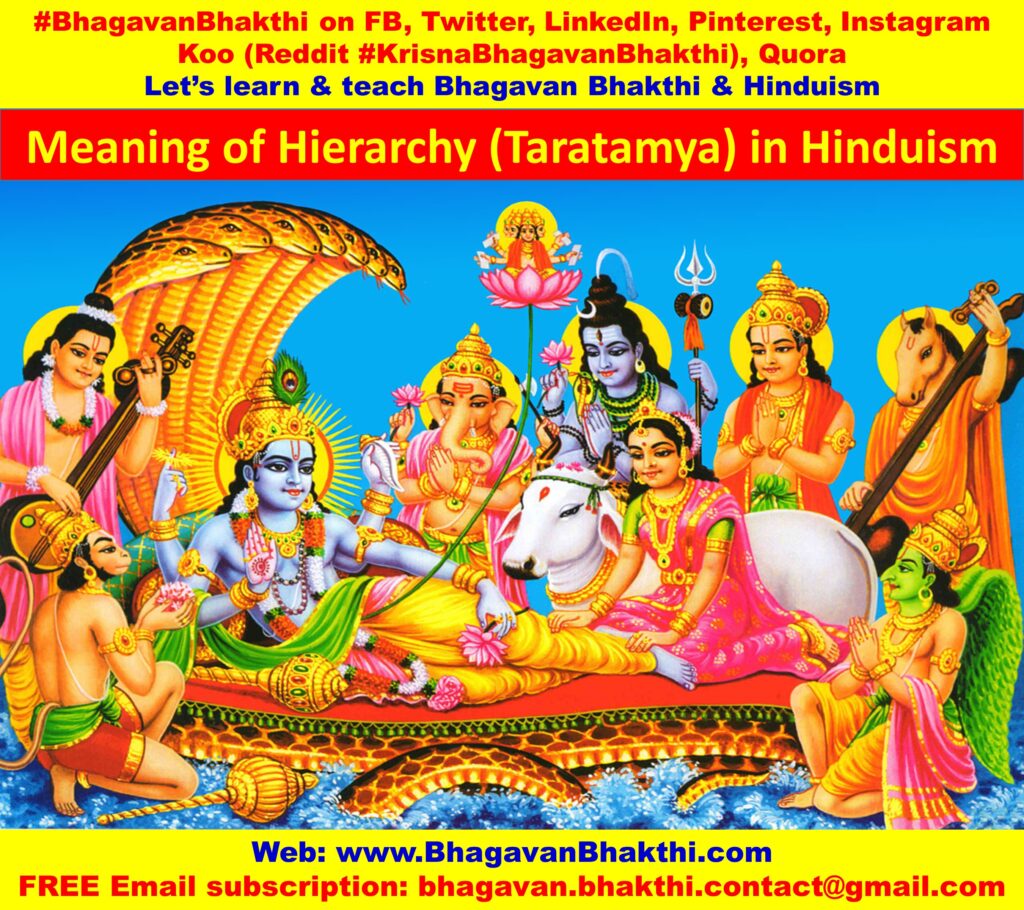
One student, every year scores 90+ in all the exams, while another student won’t be able to score even 50+ in his / her exams. Someone will be very much interested in doing acting, while someone else wants to be a dancer.
One wants to be a singer, another person wants to be an artist. One will be very good at running, another person will be very good at doing Yogasana.
Likewise, one person scores high grades in mathematics, another person scores very good marks in language. Similarly, one person eats a lot and another person get tired of eating even a little bit.
One girl runs very fast, whereas a boy can’t even walk fast. In the same way, one boy makes different face expressions, whereas another girl likes to play guitar. There are ‘n’ number of examples to give like this…
Meaning of Hierarchy (Taratamya) in Hinduism is as given below:
Hierarchy or Taratamya means differentiating someone as per one person’s capability. Few people give meaning as discrimination for Hierarchy or Tatatamya which is completely incorrect.
भेदभाव / ಭೇದಭಾವ means discrimination and Hierarchy or Taratamya means differentiating as per one’s capability.
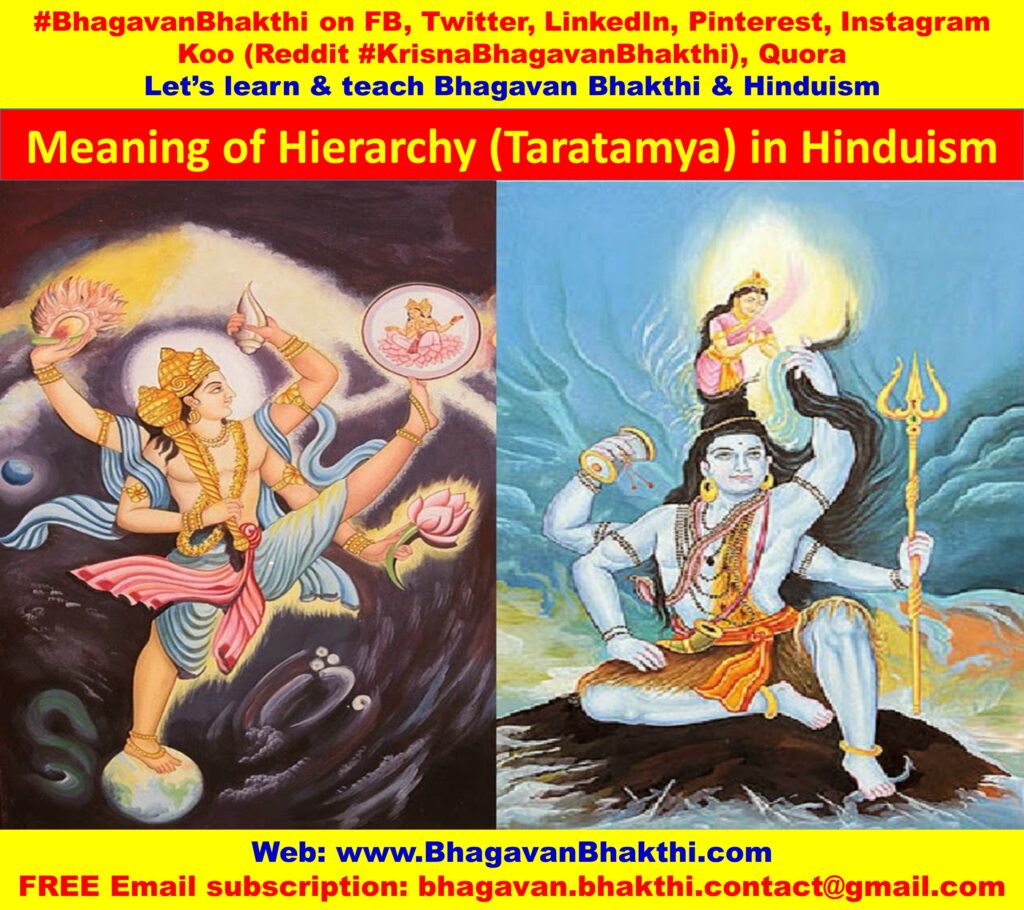
Thus with the above explanation we should be able to understand that:
1. All are unique – This means, one person’s interest can’t be another person’s interest. All are unique and all have their own way of thinking.
2. One person’s capability is more and another person’s capability is less. One is more interested in Mathematics and another person will be more interested in arts.
3. In one case a female is better and another case a male is better.
Now, let us move towards materials (matter) which are available in the markets:
Just think there are 4 different models A, B, C and D of cars of the same company. A family of 4 persons W, X, Y and Z will visit a showroom where all these A, B, C and D models of cars are displayed and are kept for sale.
W may like D, whereas X may like A, likewise Y will like B and Z will like C. All the four W, X, Y and Z will like different models.
This is because all the four are unique and have their own taste. This clearly shows that materials (matter) which are available in the market is not same for all. All have their own way of thinking and every person’s taste is different and unique.
This also shows that the models A, B, C and D which are kept for display are four different and unique models and all the four models are different and has their own style, technology, color, shape, etc.
This is what our Bhagavan Sri Vishnu says in each and every granthas (Hindu divine books).
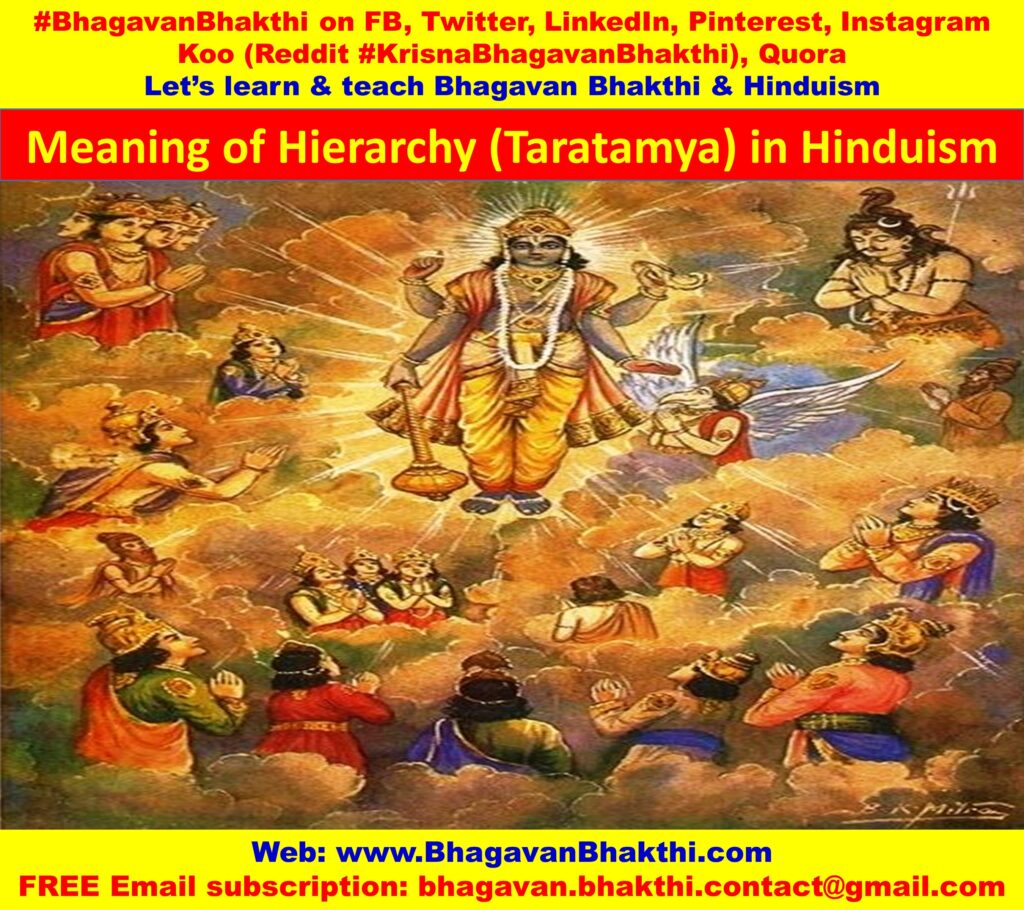
Now let us take a shloka from Bhagavad Gita:
चातुर्वर्ण्यं मया सृष्टं गुण-कर्म-विभागशः । तस्य कर्तारमपि मां विद्ध्यकर्तारमव्ययं || 4-13 ||
ಚಾತುರ್ವರ್ಣ್ಯಂ ಮಯಾ ಸೃಷ್ಟಂ ಗುಣ-ಕರ್ಮ-ವಿಭಾಗಶಃ । ತಸ್ಯ ಕರ್ತಾರಮಪಿ ಮಾಂ ವಿದ್ಧ್ಯಕರ್ತಾರಮವ್ಯಯಂ || 4-13 ||
catur-varnyam maya srstam guna-karma-vibhagasah | tasya kartaram api mam viddhy akartaram avyayam || 4-13 ||
Meaning of the above shloka : chatur-varnyam = The four varnas / divisions of human society; mayaa = Done by Me (Sri Krishna); srstam = Created; guna = quality; karma = Karma;
vibhagasah = In the form of division; tasya = Of that; kartaram = The father; api = although; mam = Me (Sri Krishna); viddhi = you may know; akartaram = As the non-doer; avyayam = Being unalterable.
Translation of the above shloka : I (Sri Krishna / Vishnu) have created four Varnas, that is – Brahmana, Kshatriya, Vaishya and Shudra based on the Karma and deeds of Jeevas (living beings).
And, although I am the creator of these four varnas, you should always remember that I am (Sri Krishna) yet the non-doer and being unalterable.
A great saint of Sri Madhwa (Dvaita) Sampradaya, Sri Raghavendra Swamy has given an extensive explanation for this shloka with the help of Sri Madhwacharya Ji’s commentary.
This Varna system explained is not limited to only India, but is applicable to the entire humanity.
On the outward way it may look like Bhagavan Sri Krishna has created these four varnas, that is, Brahmana, Kshatriya, Vaishya, Shudra. But Sri Madhwacharya Ji says this classification is not based purely on the body, but is based on aatma / soul.
Each aatma / soul has very unique nature of its own. This means, every aatma / soul is different from each. My aatma / soul is different from your aatma / soul.
Many of us know that aatmas / souls have been widely divided into three, that is, Satvika, Rajasa and Tamasa. Satvikas include all the Devatas / Demigods.
Tamasas include the Asuras and lowest level of humans. Rajasas has again divided into three divisions, that is, Rajasa-Satvika, Rajasa-Rajasa, Rajasa-Tamasa.
And again amidst these, Rajasa-Satvika group is divided into chaturvarnya i.e, Brahmana, Kshatriya, Vaishya and Shudra in Bhagavad gita.
If an aatma / soul (with the combination of Rajasa and Satvika) has greater (too high) ‘Satvika guna’ than ‘Rajasa Guna’, then he will be called as a Brahmana.
If ‘Satva Guna’ is a little more than ‘Rajasa Guna’, than he will be called as a Kshatriya. If ‘Satva Guna’ and ‘Rajo Guna’ are equal in quantity, then he will be called as a Vaishya.
If ‘Rajo Guna’ is higher than ‘Satva Guna’, then he will be called as a Shudra. This is the correct meaning of Chatur Varna as per Hinduism / Sanatana Dharma.
The above explanation clearly shows that all are unique and each and everyone has his / her own occupation as per his / her likings and capabilities.
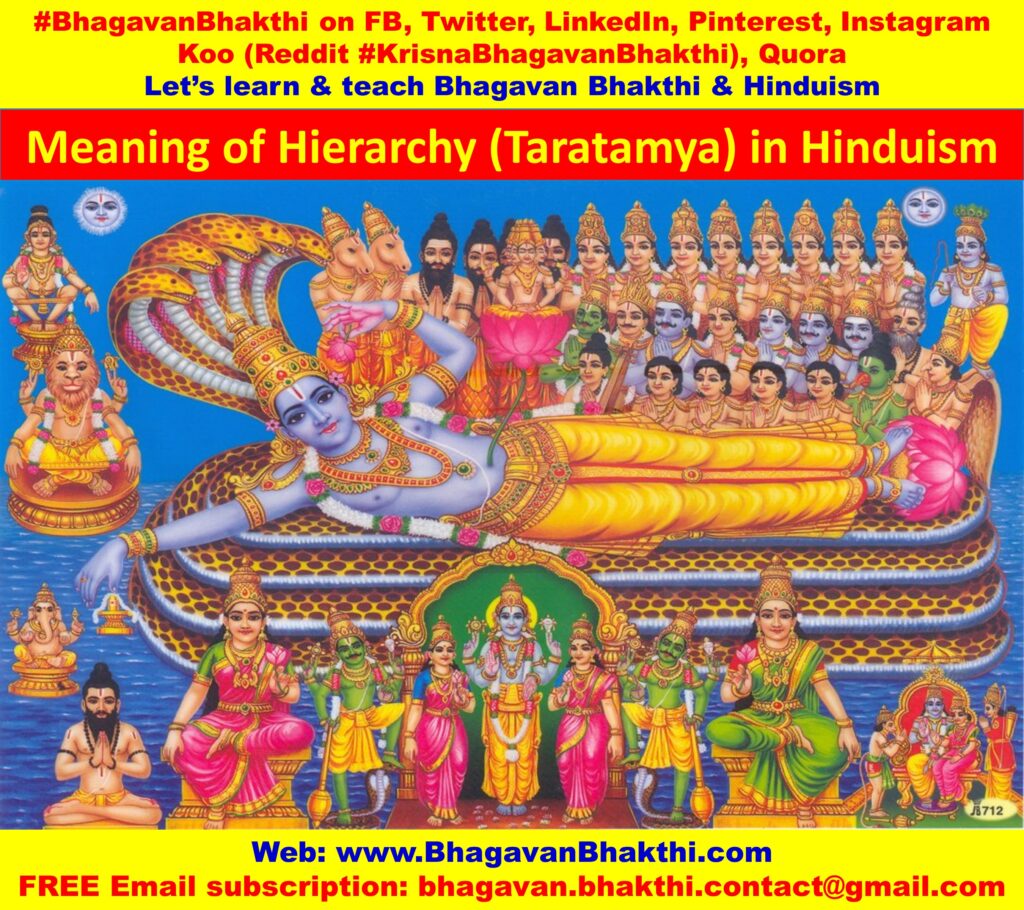
Thus the main five basic, eternal and real differences which are explained in Hinduism is as given below:
1. There is difference between the individual soul (or jīvatma) and Brahmatma (Ishvara / Vishnu). 2. There is difference between material (matter) and Ishvara / Vishnu.
3. There is difference among individual souls (jīvatma) – All are unique and different. 4. There is difference between material (matter) and jīva (individual).
5. There is difference between among various types of materials (matters).
We should always think in the right way. This post is not promoting discrimination, but wants to celebrate and promote the uniqueness of individuals.
Uniqueness starting from Bhagavan / Ishwara / Vishnu and other Devatas (Demigods):
Similarly there is uniqueness starting from the Bhagavan / Ishwara / Vishnu and other Devatas (Demigods) too. Let’s understand how?
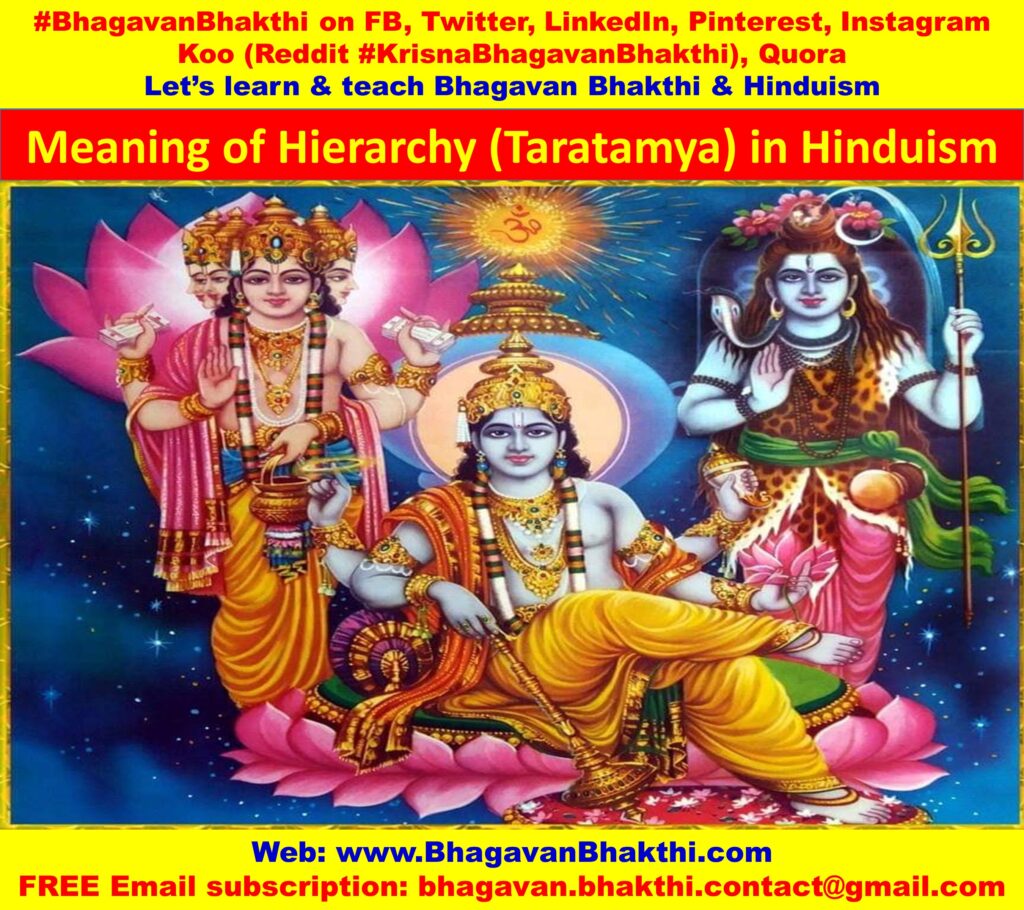
Devata hierarchy (Taratamya) – Uniqueness
1. Bhagavan Sri Vishnu – Sri Hari / Narayana / Krishna / Rama and all his avatars are same and he is the Sarvottamma / Supreme.
2. Sri Maha Lakshmi Devi – She is called as ‘Nitya Mukta‘, that is, she has received the Mukti (Divine liberation), since the ‘aadi kalam‘ (Grand first unknown time) and will be in the Mukti phase until the ‘ananta kalam‘ (Grand infinite time).
3. All Rujus, that is, Sri Brahma Deva / Sri Vayu Deva Deva. 4. All the Rujus’ consorts, that is, Sri Saraswati Devi / Sri Bharati Devi
5. Sri Garuda Deva / Sri Shesha Deva / Sri Rudra Deva. 6. ‘Shan Mahishis’ (Six consorts) of Bhagavan Sri Krishna, that is,
a) Sri Jambavati Devi, b) Sri Bhadra Devi, c) Sri Neela Devi (Or Sri Nagnajiti Devi), d) Sri Kalindi Devi, e) Sri Mitravinda Devi, f) Sri Lakshana Devi (Sri Lakshmana Devi).
7. a) Sri Sauparni Devi (Consort of Sri Garuda Deva) b) Sri Varuni Devi (Consort of Sri Shesha Deva) c) Sri Parvati (Consort of Sri Rudra Deva)
8. a) Sri Indra Deva (His name is called as Purandara) b) Sri Kama Deva – He is also called as Manmatha.
[Lord Kama Deva takes the avatar as Kartikeya / Skanda (Son of Sri Parvati Devi and Sri Rudra Deva) and he also takes the avatar as Pradyumna, that is, as the son of Bhagavan Sri Krishna and Sri Rukmini Devi]
9. Sri Ahankarika Prana. 10. a) Sri Svayambhu Manu. b) Sri Daksha Prajapati. c) Sri Bruhaspatyacharya (Guru of all the Devatas starting from Sri Indra Deva, Sri Surya Deva, Sri Chandra Deva etc.)
d) Sri Sachi Devi (Consort of Sri Indra Deva and his name is Purandara). e) Sri Rati Devi (Consort of Sri Kama Deva)
f) Sri Aniruddha (Son of Sri Kama Deva. Same Sri Aniruddha takes an avatar with the same name Sri Aniruddha as the son of Pradyumna during the Mahabharata period)
11. Sri Pravaha Vayu. 12. a) Sri Vivasvan (Sri Surya Deva). b) Sri Chandra Deva c) Sri Yama Deva d) Sri Shatarupa Devi (Consort of Sri Svaayumbhu Manu)
13. Sri Varuna Deva 14. Sri Devarshi Narada 15. a) Maharshi Bhrugu (He is best among all the Maharshis) b) Sri Agni Deva c) Sri Prasooti (Consort of Sri Daksha Prajapati)
16. a) Sri Mareechi b) Sri Atri c) Sri Angirasa d) Sri Pulastya e) Sri Pulaha f) Sri Kratu g) Sri Vashishtha h) Sri Vaivasvata Manu i) Sri Vishwamitra (He is the head of all the Pitru Devatas)
(The above given ‘a’ to ‘g’ are Brahma Manasa Putras – Born from the divine mind of Sri Brahma Deva)
17 a) Sri Mitra b) Sri Niraruti c) Sri Praavahi Devi (Consort of Pravaha Vayu) d) Sri Tara Devi (Consort of Sri Bruhaspati – Guru of the Devatas)
18 a) Sri Vishvaksena b) Sri Ganesha (Son of Sri Rudra Deva and Sri Parvati Devi)
c) Sri Ashwini Devatas (There names are Naasatya & Dasra – They take the avatar as Nakula and Sahadeva in the Mahabharata period and as Meinda and Vivida during the Ramayana period)
d) Sri Kubera Deva e) Sri Shesha Shatastha Somarasapaanaarhas (For details, please see in the Somarasapaanaarha section)
19. Karmaja Devatas (Kaksha-19) a. All the Dvarapalakas b. Sri Mareechi (Son of Sri Vayu Deva) c. Sri Paavaka (Son of Sri Agni Deva) d. Sri Jayanta (Son of Sri Indra Deva)
e. Sri Vishvakarma f. Sri Shata Punya Shloka Rajas g. All the Rishis, h. All the Vishnu Parshadas i. All the Gandharvas j. 92 Apsara Devis
k. 7 Pitrus, that is, they are called as ‘sapta pitru devatas’ (Also called as ganas). There names are Yama, Soma, Kavyavahana, AgniShTAta, Aryama, Anala, BarhiShat).
l. All the Manus m. All the Indras (Not the Svarga loka Indra Deva) n. All the Yagnya Sadhanaabhimaani Devatas o. All the Archara Marga Devatas p. All the Dhoomaadi Maarga Devatas
q. All the Grahas r. Sulekha Naamaka Chitragupta s. All the Dik-abhimani Devatas t. All the Ab-abhimani Devatas u. All the Vahanas (mounts) of Devatas
v. Sri Maalagaara Sudhaama w. GaNa Naamaka ChanDaka x. Kaalaakhya-abhimani Devata
20. a) Sri Parjanya (Mega-abhimani Devata) b) Sri Ganga Devi (Consort of Sri Varuna Deva) – The most sacred and divine river on earth. c) Sri Sanjnya Devi (Consort of of Vivasvan Surya Deva)
d) Sri Rohini Devi (Consort of Sri Chandra Deva) e) Sri Viradusha Devi (Consort of Sri Aniruddha – She is the BrahmAnda-abhimani Devata) f) Sri Shyamala Devi (Consort of Sri Yama Deva)
21. Kurma-adi anAkhyAta Devatas 22. Sri Svaaha Devi (Consort of Sri Agni Deva – She is mantra-abhimani Devata) 23. Sri Budha Deva (Jala-abhimani Devata)
24. a) Sri Devaki Devi – Mother of Bhagavan Sri Krishna (She is same as Sri Aditi Devi) b) Sri Yashoda Devi – Foster mother of Bhagavan Sri Krishna c) Sri Usha Devi (Consort of Sri Ashvini Devatas – She is the NAma-abhimani Devata)
25. a) Sri Shanaishchara (Sri Shani Deva) b) Sri Dhara Devi 26. Sri Pushkara (KarmAbhimAni)
27a. All the AjAnaja Devatas – Aajaanaja Devatas (Kaksha 27) – Aakhyaata Aajaanaja Devatas: i. 92 Gandharvas ii. Kratu iii. Sindhu iv. 908 Apsara Devis (Among this 92 appear in Kaksha 19)
v. 16,100 Children of Sri Agni Deva (These are the children who get married to Bhagavan Sri Krishna – Narakasura had kidnaped all these Devis – Totally Bhagavan Sri Krishna marries 16,108 divine Devis – The remaining eight are called ‘Ashta Mahishi’)
27b. Anaakhyaata Aajaanaja Devatas: i. All the Vibudhas (Total 100 in number) ii. All the Deva Bhrutya Pitrus (Total 100 in number) iii. All the Deva Bhrutya Asuras (Total 100 in number)
iv. All the Deva Gaayana Gandharvas (Total 100 in number) v. All the Deva Nrutya Apsara Devis (Total 100 in number) vi. All the Siddha Sanketas (Total 70 in number) – (Deva Karya Nirvaahakas)
vii. All the Vahana carriers YakSharas (Total 70 in number) viii. All the Shibika carriers RakShasas (Total 30 in number) ix. All the Deva Paricharaka Chaaranas (Total 30 in number)
x. All the Sevaakarta Bhutas (Total 70 in number) xi. All the Kinnaras (Total 70 in number) xii. All the Pishachas (Total 70 in number) xiii. All the Kubera Bhrutya Guhyakas (Total 7 in number)
xiv. All the Pretas (Total 70 in number) xv. All the Vidyadharas (Total 70 in number) xvi. All the Varuna Bhrutya Naagas (Total 5 in number) xvii. All the Shata-una ShatakoTi Rishis
28. All the Chira Pitrus 29. All the Deva Gandharvas 30. All the Manushya Gandharvas 31. All the Kshitipas (All the Maanusha Chakravartis)
32. All the ManushyOttamas – i. Nara ii. Bhuchara iii. Khechara iv. Krimi v. Truna
Somarasa-Paanaarhas (See above)
There are 100 Somarasa Paanaarhas and their names are as given below:
i. Higher Kaksha than Kaksha 18 : 13 ii. Kaksha 18 : 84 iii. Lower Kaksha than Kaksha 18 : 3
A. Higher Kaksha than Kaksha 18 (Count of 13): i. Urukrama (Kaksha 1 – One among Adityas – Avatar of Bhagavan Sri Hari)
ii. Pradhana Vayu (Kaksha 3 – One among Adityas – Sri Bharati Devi’s husband – Sri Mukhya Prana Deva / Vayu Deva)
iii. Sri Rudra Deva [Kaksha 5 – One among Ekadasha Rudras – Vaama (Another name of Sri Rudra Deva / Shiva)] iv. Sri Indra Deva (Kaksha 8 – One among Adhityas – His name is Purandara)
v. Ahankarika Prana (Kaksha 9 – One among Marutas) vi. Bruhaspati (Kaksha 10 – He is the Guru of all the Devatas) vii.. Pravaha Vaayu (Kaksha 11 – One among Marutas)
viii. Sri Chandra Deva (Kaksha 12) ix. Sri Yama Deva (Kaksha 12) x. Sri Vivasvan (Kaksha 12 – One among Adityas) xi. Sri Varuna Deva (Kaksha 13 – one among Adityaas)
xii. Sri Agni Deva (Kaksha 15 – One among Ashta Vasus) xiii. Mitra (Kaksha 17 – one among Adityas)
B. Kaksha 18 (Count of 84): a. Ashta Vasu (Total 8 number — one appear in other kaksha)
i. Drona ii. Dhruva iii. Dosha iv. Arka v. PraNa vi. Dyu (He takes avatar as Bhishma during the Mahabharata period) vii. Vibhavasu
One Vasu ‘Agni’ appears in Uttama Kaksha – 15
b. Ekadasha Rudras (Total 11 numbers — one appear in other Kaksha)
i. Bhima (Not the Bhima of Mahabharata) ii. Raivata iii. Oja iv. Ajaikapaat v. Mahan vi. Bahurupaka vii. Bhava viii. Ugra ix. Vrushaakapi x. Ahirbudhni
(One Rudra, that Lord Shiva called ‘Vaama’ the husband of Sri Parvati Devi appears in Uttama Kaksha – 5)
c. Dwadasha Adityas (Total 12 number — six appear in other Kakshas) – i. Bhaga ii. Poosha iii. Savitru iv. Dhaata v. Aaryama vi. TvasTru
Six Adityas appear in different Kakshas: Of these 5 Adityas appear in Uttama (higher) Kaksha:
i. Urukrama – Kaksha 1 ii. Indra – Kaksha 8 iii. Vivasvan – Kaksha 12 iv. VaruNa – Kaksha 13 v. Mitra – Kaksha 17
One appear in Adhama Kaksha: Parjanya – Kaksha 20
d. Marut GaNa (Total 49 in number — Two appear in other Kakshas) – i. PraaNa ii. Apaana iii. Vyaana iv. Udaana v. Samaana vi. Naaga vii. Koorma viii. Krukala ix. Devadatta x. Dhananjaya xi. Aavaha
xii. Paraavaha xiii. Samvaha xiv. Shamyu xv. Udvaha xvi. Vivaha xvii. Shanku xviii. Kaala xix. Shvaasa xx. Nala xxi. Anila xxii. Pratibha xxiii. Kumuda xxiv. Kaanta
xxv. Shuchi xxvi. Shveta xxvii. Ajita xxviii. Guru xxix. Jhunjhu xxx. Samvartaka xxxi. Keela xxxii. Jita xxxiii. Soumya xxxiv. Kapi xxxv. JaDa xxxvi. Mandooka
xxxvii. Samhruta xxxviii. Siddha xxxix. Rakta xl. KrushNa xli. Pika xlii. Shuka xliii. Yati xliv. Bheema xlv. Hanu xlvi. Pinga xlvii. Kampana
Two Maruts “Ahankaarika PraaNa – Kaksha 9” and “Pravaha Vaayu – Kaksha 11” appeared in Uttama Kaksha
Note: i. PraaNa, Apaana, Vyaana, Udaana, Samaana are Daasa PraaNas
ii. Sri Bharati Devi husband Sri Mukhya PraaNa Deva has 5 roopas with the same 5 names and those shouldn’t be confused with Daasa PraaNas.
e. Vishvedevatas (Total 10 in number – All appear in this Kaksha) – i. Puroorava ii. Aardava iii. Kaala iv. Kaama v. Dhuri vi. Lochana vii. Satya viii. Vasu ix. Daksha x. Kratu
f. Ashwini Devatas (Total 2 numbers) – i. Naasatya (Same as Nakula of Mahabharata and Meinda of Ramayana) ii. Dasra (Same as Sahadeva of Mahabharata and Vivida of Ramayana)
g. Others in this Kaksha (Total 2 numbers) – i. Dyaava ii. Rubhu
Total Count in Kaksha 18 = AshTa Vasu (7) + Ekaadasha Rudra (10) + Dwaadasha Aditya (6) + Maruth GaNa (47) + Vishvedevata (10) + Ashwini Devata (2) + Others (2) = 84
iii. Lower Kaksha than Kaksha 18 (Total 3 number): In Kaksha 19: Kavyavaaha. In Kaksha 20: Parjanya – One among Adityas. 5 appeared in Kakshas between 1 & 17, 6 appeared in Kaksha 18
In Kaksha 25: Prithvi. Dwaarapalakas – There are 56 Dvaarapalakas: 7 AvaraNas * 8 dhvArapAlakas = 56 Dvaarapalakas i. Jaya ii. Vijaya
Others are Shata Punya Shloka Rajaas – i. Prahlada ii. Priyavrata iii. Uttaanapaada iv. Gaya v. Maandhaata vi. Prithu vii. Shashibindu viii. Kaartaveerya
ix. Kakutya x. Daushyanti xi. Bharata xii. Pareekshitha xiii. Janaka xiv. Haihaya xv. Arshabha xvi. Others
Rishis (Total number are Shata KoTi Rishis – 8 appear in Uttama Kaksha & Shata-Una Shata Koti appear in Adhama Kaksha – There are 92 Rishis in this Kaksha)
i. Chyavana ii. Uchitthya iii. Kardama iv. Kashyapa v. Sanaka vi. Sanandana vii. Sanatsujaata viii. Others
Names of Gandharvas: i. HaaHaa ii. HuHu iii. DhrutaraashTra iv. Tumbura v. Chitraratha vi. Vishvaavasu vii. Paraavasu viii. Vidyaadhara
Names of Manus (Total number is 14 – Three Belong to Uttama Kaksha): i. Svaayambhu [Kaksha 10] ii. SvaarOchiSha iii. uttama iv. Taapasa [Kaksha 1 – Bhagavan Sri Hari] v. Raivata
vi. ChakShusha vii. Vaivasvata [Kaksha 16] viii. SaavarNi ix. DakshsaavarNi v. BrahmasaavarNi xi. DharmasaavarNi xii. RudrasaavarNi xiii. DevasaavarNi xiv. IndrasaavarNi
Names of Indras (Total number is 14 – Seven appear in Uttama Kaksha): i Yagnya [Kaksha 1 – Sri Hari] ii. ROchana [Kaksha 3 – MukhyapraaNa] iii. Satyajitu [Kaksha 12 – Yama]
iv. Vibhu [Kaksha 18 – Dasra (Ashvini Devata)] v. Trishikha [Kaksha 18 – Naasatya (Ashvini Devata)] vi. Mandaradyumna [Kaksha 8 – Sachipati Indra]
vii. Purandara [Kaksha 8 – Sachipati Indra] viii. Bali ix. Adbhuta x. Shambhu xi. Vidhruta xii. Krutadhaama xiii. Divaspati xiv. Dhrutashuchi
Names of Grahas (Total number is 9 – Five appear in Uttama & Adhama Kaksha):
i. Guru [Kaksha 10 – Bruhaspatyaacharya] ii. Surya [Kaksha 12] iii. Chandra [Kaksha 12] iv. Raahu v. Ketu vi. Mangala vii. Shukra vii. Budha [Kaksha 23] ix. Shani [Kaksha 25]
Names of Vahanas (Mounts): i. Nandi i. Hamsa iii. Others
More information will be added to this on regular basis, please visit after some time to know more information.
To watch videos on #Hinduism #Sanskrit language, SUBSCRIBE to my YouTube channel from this link: #BhagavanBhakthi YouTube channel
To watch the YouTube video of “Hierarchy (Taratamya) of Hindu Gods”, please click the below YouTube video link:
To know more about Bhagavan Sri Narasimha, please visit this link: Bhagavan Sri Narasimha posts on Bhagavan Bhakthi website
To know more about Bhagavan Sri Vishnu, plase visit this link: Bhagavan Sri Vishnu posts on Bhagavan Bhakthi website
To know more about Bhagavan Sri Krishna, please visit this link: Bhagavan Sri Krishna posts on Bhagavan Bhakthi website
To know more about Bhagavan Sri Rama, please visit this link: Bhagavan Sri Rama posts on Bhagavan Bhakthi website
Dear friends, if you need any clarifications about this post, kindly let me know, I will definitely try to answer all of them.
Also your one LIKE, one COMMENT, One Share, one SUBSCRIPTION is highly important.
This will help to know the quality of this content and also it will be helpful to know if any improvements is required for the content.
If you feel this content is useful to you and has helped you to improve your knowledge, kindly share this with your well-wishers.
Because “SHARING MEANS CARING”.
For receive FREE EMAIL SUBSCRIPTION about #BhagavanBhakthi, you can send an email to bhagavan.bhakthi.contact@gmail.com from your email ID.
NAMASTE!
Sri Gurubhyo Namaha
Sri Venkateshaaya Namaha
Sri Krishnaarpanamastu
Your point of view caught my eye and was very interesting. Thanks.
Your article helped me a lot, is there any more related content? Thanks!
You can go through my other posts, you will find more information.